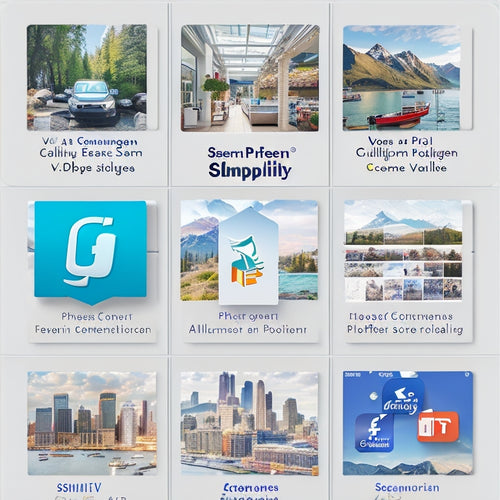
Optimize Online Shopping Experiences With 5 Pro Tips
Share
You can greatly enhance your online store's conversion rates and customer satisfaction by focusing on the five key areas that make or break the online shopping experience. Start by streamlining your checkout process to reduce friction and cart abandonment. Then, personalize product recommendations to increase cross-selling and upselling. Don't forget to enhance your mobile shopping experience, implement efficient search filters, and strategically leverage social proof to build trust. By mastering these five areas, you'll be well on your way to creating a seamless and engaging online shopping experience that drives sales and loyalty. Now, take the next step to discover how.
Key Takeaways
• Simplify checkout processes by reducing steps, auto-filling fields, and offering guest checkout to minimize friction and cart abandonment.
• Personalize product recommendations using AI-driven technology and customer feedback to increase cross-selling and upselling opportunities.
• Optimize mobile shopping experiences by streamlining checkout, minimizing loading times, and ensuring website responsiveness to different screen sizes.
• Implement efficient search filters that provide intuitive navigation, categorize products, and reduce bounce rates by displaying relevant results.
• Leverage social proof strategically by showcasing customer reviews, ratings, and influencer collaborations to build trust and increase conversion likelihood.
Streamline Checkout Process Flows
Simplify your checkout process by breaking it down into clear, concise steps, allowing customers to swiftly complete their transactions. This is pivotal in reducing friction, a major obstacle that leads to cart abandonment.
When you streamline your checkout process, you're making it easier for customers to convert. By minimizing the number of steps, you're reducing the likelihood of errors and frustration. Make sure to auto-fill fields whenever possible, and provide a guest checkout option to speed up the process.
Additionally, consider implementing a progress bar to keep customers informed of their progress. This will help build trust and make them feel more in control.
By streamlining your checkout process, you'll see a significant increase in conversions. In fact, a study found that optimizing the checkout process can lead to a 35% increase in conversions.
Don't let a clunky checkout process hold you back from meeting your sales goals. By following these tips, you'll be well on your way to creating a seamless checkout experience that drives sales and boosts customer satisfaction.
Personalize Product Recommendations
By tailoring product recommendations to individual customer preferences, you can increase the likelihood of cross-selling and upselling, ultimately driving average order value and customer loyalty. This is where AI-driven recommendations come into play.
By leveraging machine learning algorithms, you can analyze customer behavior, purchase history, and browsing patterns to suggest relevant products that align with their interests. This personalized approach not only enhances the shopping experience but also builds trust and credibility with your customers.
To take it to the next level, consider incorporating real-time recommendations that adapt to customers' changing preferences. For instance, if a customer has abandoned their cart, you can send them personalized emails with recommendations based on their previous purchases or browsing history.
Additionally, use customer feedback and ratings to refine your recommendations, ensuring they're accurate and relevant. By doing so, you'll be able to increase conversions, reduce cart abandonment, and foster long-term customer relationships.
Enhance Mobile Shopping Experiences
As you focus on personalizing product recommendations, don't overlook the importance of optimizing your mobile shopping experience, where a seamless and intuitive interface can make all the difference in converting browsers into buyers.
Mobile optimization is essential, as most online shoppers use their mobile devices to browse and make purchases. A user-friendly interface guarantees that customers can easily navigate your site, find what they're looking for, and complete their transactions without any hassle.
To boost conversion rates, you need to prioritize customer engagement on mobile. This means streamlining your checkout process, minimizing loading times, and making sure that your website is responsive and adaptable to different screen sizes.
Implement Efficient Search Filters
You can greatly enhance your customers' shopping experience by implementing efficient search filters that help them quickly find the products they're looking for. This is especially important when dealing with a vast product catalog, as it can be overwhelming for customers to sift through countless options. By providing them with intuitive search filters, you're empowering them to narrow down their search and discover relevant products with ease.
Here are three key benefits of implementing efficient search filters:
-
Improved navigation: Customers can quickly navigate through your product catalog, reducing the time spent searching for specific items.
-
Better categorization: Search filters help categorize products into logical groups, making it easier for customers to find related items.
-
Reduced bounce rates: By providing relevant search results, you're reducing the likelihood of customers leaving your site due to frustration or confusion.
Leverage Social Proof Strategically
You know that trust is an essential factor in online shopping, and social proof is a powerful tool to build it. Seventy percent of online shoppers trust customer reviews more than product descriptions, making social proof an integral element in driving sales and building brand credibility.
To leverage social proof strategically, you should integrate customer reviews and testimonials into your product pages. This will give potential customers a sense of security and confidence in their purchasing decisions.
Influencer collaborations are another effective trust-building tactic. Partner with influencers who align with your brand values and target audience to showcase your products in real-life scenarios. This won't only increase brand awareness but also provide social proof to potential customers.
Additionally, consider showcasing ratings and reviews from other customers on your product pages. This will help build trust and credibility with potential customers, increasing the likelihood of conversion.
Frequently Asked Questions
How Do I Handle Abandoned Carts and Encourage Customers to Complete Purchases?
You tackle abandoned carts by implementing cart recovery strategies that boost customer engagement, such as sending targeted abandoned cart emails with purchase incentives, like exclusive discounts, to encourage customers to complete their purchases.
What Is the Ideal Frequency for Sending Promotional Emails and Offers?
You'll strike gold when you tailor your email frequency to individual preferences, using email segmentation and clever timing strategies to deliver personalized content that sparks customer engagement, without being too pushy or too quiet.
Can I Use Ai-Powered Chatbots to Provide 24/7 Customer Support?
You can leverage AI-powered chatbots to provide 24/7 customer support, boosting chatbot efficiency and customer satisfaction by resolving routine inquiries and freeing human reps to tackle complex issues.
How Do I Ensure Website Security and Protect Customer Data From Cyber Threats?
'Imagine a hacker infiltrating your site, like the 2017 Equifax breach. To prevent this, you guarantee website security by implementing data encryption, two-factor authentication, and providing regular cybersecurity training to employees, while continuously monitoring for threats.'
What Metrics Should I Track to Measure the Success of My Online Shopping Platform?
You track conversion rates, customer satisfaction, and user engagement to gauge your online shopping platform's success, while also monitoring average order value to optimize revenue and identify areas for improvement.
Related Posts
-
A Quick Comparison of the Best Shopify Sitemap Apps
This article provides a concise comparison of the top Shopify sitemap apps. It aims to present an objective analysis...
-

What Integrations Does Shopify Have
This article aims to provide an overview of the integrations available on the Shopify platform. By exploring the ben...
-

The Power of Personalized Content
The power of personalized content is a topic of interest that delves into the advantages and difficulties associated...

